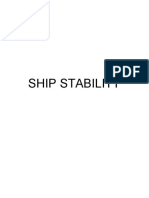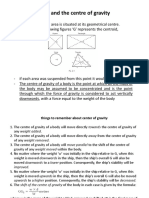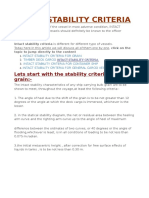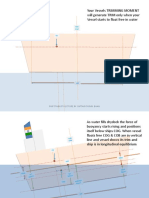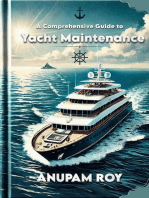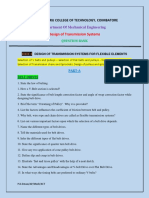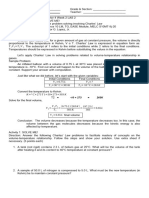0 ratings0% found this document useful (0 votes)
125 viewsTransverse Stability of Ship
Transverse Stability of Ship
Uploaded by
Irakli ShavishviliUnder small angles of heel (less than 10 degrees), a ship's stability is determined by its metacentric height (GM), which is the distance between its center of gravity (G) and transverse metacentre (M). A positive GM provides initial stability, while a negative GM results in unstable equilibrium. GM can be measured through an inclining experiment. A ship's range of stability, represented by curves of stability, indicates the angle it can heel before capsizing and is a better measure of stability than GM alone. Stability at large angles of heel is more complex and accounted for through formulas like Atwood's formula or by considering the ship to be wall-sided.
Copyright:
© All Rights Reserved
Available Formats
Download as PPT, PDF, TXT or read online from Scribd
Transverse Stability of Ship
Transverse Stability of Ship
Uploaded by
Irakli Shavishvili0 ratings0% found this document useful (0 votes)
125 views12 pagesUnder small angles of heel (less than 10 degrees), a ship's stability is determined by its metacentric height (GM), which is the distance between its center of gravity (G) and transverse metacentre (M). A positive GM provides initial stability, while a negative GM results in unstable equilibrium. GM can be measured through an inclining experiment. A ship's range of stability, represented by curves of stability, indicates the angle it can heel before capsizing and is a better measure of stability than GM alone. Stability at large angles of heel is more complex and accounted for through formulas like Atwood's formula or by considering the ship to be wall-sided.
Copyright
© © All Rights Reserved
Available Formats
PPT, PDF, TXT or read online from Scribd
Share this document
Did you find this document useful?
Is this content inappropriate?
Under small angles of heel (less than 10 degrees), a ship's stability is determined by its metacentric height (GM), which is the distance between its center of gravity (G) and transverse metacentre (M). A positive GM provides initial stability, while a negative GM results in unstable equilibrium. GM can be measured through an inclining experiment. A ship's range of stability, represented by curves of stability, indicates the angle it can heel before capsizing and is a better measure of stability than GM alone. Stability at large angles of heel is more complex and accounted for through formulas like Atwood's formula or by considering the ship to be wall-sided.
Copyright:
© All Rights Reserved
Available Formats
Download as PPT, PDF, TXT or read online from Scribd
Download as ppt, pdf, or txt
0 ratings0% found this document useful (0 votes)
125 views12 pagesTransverse Stability of Ship
Transverse Stability of Ship
Uploaded by
Irakli ShavishviliUnder small angles of heel (less than 10 degrees), a ship's stability is determined by its metacentric height (GM), which is the distance between its center of gravity (G) and transverse metacentre (M). A positive GM provides initial stability, while a negative GM results in unstable equilibrium. GM can be measured through an inclining experiment. A ship's range of stability, represented by curves of stability, indicates the angle it can heel before capsizing and is a better measure of stability than GM alone. Stability at large angles of heel is more complex and accounted for through formulas like Atwood's formula or by considering the ship to be wall-sided.
Copyright:
© All Rights Reserved
Available Formats
Download as PPT, PDF, TXT or read online from Scribd
Download as ppt, pdf, or txt
You are on page 1of 12
Stability under small angle of heel.
For small angle of heel about 10˚, the vertical through
shifted Centre of buoyancy B1 intersects the ships
centre line at M, called Transverse Metacentre
Distance between Centre of gravity G and transverse
metacentre M is called Metacentric Height and this
is denoted by GM.
For small angle of heel the vertical drawn from G to
line drawn through shifted buoyancy B1 and
transverse metacentre M intersect at a point Z. GZ is
called the Righting Lever.
From figure it can be seen that GZ = GMSinθ
Stability under small angle of heel.
Under the condition of small heel upto 10˚, the weight of
the vessel creating a moment of ▼g x GZ will try to
return the ship to upright position. This is called
Righting Moment.
For small heels less than 10˚ heel, it is usual to express
Initial Stability of ship in terms of GM.
GM is positive if G lies below M and negative if G lies
above M.
For all positive values of GM the ship is in Stable
Equilibrium.
If GM is small, the righting moment is less and at any
angle of heel ship will roll easily. Such a ship is said to be
Tender.
Stability under small angle of heel.
If GM is large, the righting moment is more and at any
angle of heel ship will have considerable resistance to
rolling. Such a ship is said to be Stiff .
When centre of gravity and transverse metacentre
coincide, there is no righting moment. Ship will then
remain inclined to any angle of heel and said to be in
Neutral Equilibrium.
If GM is negative, the righting moment acts in the
opposite direction increasing the angle of heel. The vessel
is said to be in Unstable Equilibrium and will not
return to the upright position.
Reduction in height of G will make the ship stable and
increase in G will make the ship unstable.
Finding the position of M
Derive the equation BM= I/▼
BM is also called as Transverse metacentric radius, as
the ship will roll with respect to M.
Height of transverse metacentre above keel is denoted
by KM and the following expression gives it value.
KM = KB + BM.
KB is the height of centre of buoyancy above keel and
is calculated using any method explained earlier.
Show that for a box barge KM= d/2(KB) +B2/12d (BM).
Show that for a triangular barge KM = 2/3d+ 25/96d.
Plot these values of KB, KM on x-axis and draft on y-
axis to represent Metacentric Diagram
Curves of stability
When a ship is built, the deadweight, lightweight and
the centre of gravity of light ship is calculated.
When the ship is nearly completed, the “inclining
experiment” is performed to find the metacentric height
(GM)of the ship in light condition.
KM the transverse metacentric height from keel is
calculated by adding KB (Centre of buoyancy from keel)
& BM (ICL/▼).
Then KG = KM-GM.
These information are tabulated in the “Dead Weight
Scale”or given in the form of graphs called “Curve of
Stability”.
Inclining Experiment
This is a simple experiment carried out on the
completed ship to determine metacentric height.
Derive the formula GM = m x d x l/ ∆ x a where m is
the mass moved across, d is the distance moved cross,
l is the length of pendulum, a is the deflection of
pendulum ∆ is the displacement.
Range Of Stability is the angular range, over which
ship will have positive statical stability. It indicates
the angle to which the ship will heel before she would
capsize.
Ship’s initial stability does not indicate what her
range of stability likely to be and vice versa.
A ship with a large initial stability may have a large or
small range of stability.
Practical Considerations of stability
It is possible for a ship to have negative initial stability ,
yet to become stable at a small angle of heel and there
after to be able to heel to quite a large angle, before she
capsize.
There are two types of Lists, temporary & permanent.
A) Centre of gravity is away from the centre line of the
ship in the transverse direction due to uneven loading or
ballast.
B) If the ship has a negative metacentric height (GM).
If adequate range of stability is there, these conditions
are not dangerous.
The ship will start heeling till the B comes vertically
under G after which ship will be in equilibrium.
Angle of Loll.
Any further heel will be resisted by righting lever.
In the case of negative GM the list can be to either side
under the influence of external forces.
It also can change from one side to other.
It may increase or decrease when weights are added or
removed.
The angle at which the ship will stabilize under the
above condition is called the Angle of Loll.
Under this condition the righting lever GZ is zero.
Or from stability formula of Wall sided ship
GZ = sinθ (GM+1/2BM tan2 θ) we can estimate angle of
loll.
Angle of Loll.
sinθ (GM+1/2BM tan2 θ) has to be zero either sinθ=0 or
GM+1/2BM tan2 θ =0 .
As vessel already has an angle of heel, θ≠ 0 and sinθ≠0
Then GM+1/2BM tan2 θ =0 .
GM =- 1/2BM tan2 θ
tan2 θ = -2GM/BM
Tanθ = √-2GM/BM
In this condition initial GM is already negative,
-2GM/BM will be +ive.
Thus angle of loll can be estimated for unstable ships.
Stability At Large Angle of Heel
The proof of the formula for BM was based on three
assumptions which are nullified for large angles heels.
1) The two water planes intersect at centre line
2) The wedges are Rt.angled triangles.
3) The transverse metacentre also does not remain at
a fixed point.
The GZ value in this case is given by two Formulae.
Atwood’s Formula: GZ = (v x hh1 /▼) – BG sinθ
v is the volume of the wedge
hh1 is the horizontal component of shift of g.
Stability At Large Angle of Heel
Stability of a wall-sided ship
If the vessel is assumed to be wall-sided in the vicinity of
the water plane, the righting lever may be estimated
from the expression GZ = sinθ (GM+1/2BM tan2 θ)
Dynamical Stability
Dynamic stability is the amount of work done in
inclining the ship to a given angle of heel.
Work done= Force exerted x distance over which the
ship is heeled = Sum of all the righting moments of
statical stability for every angle of heel up to the given
angle.
For this, the vertical distance to the curve are always
measured in terms of statical stability and length along
the base line in terms of circular measure (Radians)
Dynamical Stability
We can use Simpson’s rule to calculate the area under
the curve and thus find dynamic stability.
It is also calculated as the displacement x vertical
separation of centre of gravity and buoyancy.
You might also like
- Unit 6 Stability and Trim Edited PPTDocument31 pagesUnit 6 Stability and Trim Edited PPTYhalewin Onda100% (1)
- Test Stabillity 1 2009Document6 pagesTest Stabillity 1 2009Yuriy Kakaranze0% (1)
- 5 Influence LinesDocument18 pages5 Influence LinesSteven KuaNo ratings yet
- A General Discussion On Ship StabilityDocument6 pagesA General Discussion On Ship StabilityAnonymous UCveMQNo ratings yet
- 47 5815 MT222 2015 1 1 1 Ch.6 Transverse Statical Stability-ADocument23 pages47 5815 MT222 2015 1 1 1 Ch.6 Transverse Statical Stability-AManoj KumarNo ratings yet
- f0lc 35 Ship Stability - Theory App - Outcome 3 - Cover Sections 1-3Document33 pagesf0lc 35 Ship Stability - Theory App - Outcome 3 - Cover Sections 1-3Amit Chahande100% (1)
- Seam 4 ADocument4 pagesSeam 4 ARoy CamajalanNo ratings yet
- Damaged StabilityDocument4 pagesDamaged StabilityUjjwal VermaNo ratings yet
- Damage Stability CalculationsDocument12 pagesDamage Stability Calculationsleotvrde100% (1)
- SHIP B - Data-Booklet-MCA-SQA-Chief-Mate-Stability-Book-B-V1.2-January-2022Document69 pagesSHIP B - Data-Booklet-MCA-SQA-Chief-Mate-Stability-Book-B-V1.2-January-2022ShanilNo ratings yet
- Ship StabilityDocument12 pagesShip StabilityribbyNo ratings yet
- Section 23 Intact and Damage Stability: I - Part 6 GL 2010 Page 23-1Document8 pagesSection 23 Intact and Damage Stability: I - Part 6 GL 2010 Page 23-1JAAK2005No ratings yet
- Lesson-1 Introduction To Stability: BM KMDocument75 pagesLesson-1 Introduction To Stability: BM KMPulung WNo ratings yet
- Stability Theory IIIDocument32 pagesStability Theory IIISergio RuedaNo ratings yet
- Intact Stability For All ShipsDocument1 pageIntact Stability For All ShipsAnil PatidarNo ratings yet
- Initial Transverse Metacenter CugalDocument19 pagesInitial Transverse Metacenter CugalPete KatipunanNo ratings yet
- GZ CURVE and GMDocument3 pagesGZ CURVE and GMSuresh Panneer100% (1)
- Ship Stability: Damaged Stability of ShipsDocument11 pagesShip Stability: Damaged Stability of ShipsgeorgesagunaNo ratings yet
- 1.0 Movement of GDocument398 pages1.0 Movement of GГенна ФелексовNo ratings yet
- Ship Stability NomenclatureDocument6 pagesShip Stability NomenclatureRoderick EstrellaNo ratings yet
- Steering Gear1Document31 pagesSteering Gear1Monindika WarshakoonNo ratings yet
- Stabilitas KapalDocument65 pagesStabilitas KapaltutengNo ratings yet
- Damage StabilityDocument58 pagesDamage StabilitysuryachalapraveenNo ratings yet
- MLC f42Document2 pagesMLC f42harry stamper100% (1)
- 2R SquatDocument11 pages2R SquatInsan Ahammad100% (1)
- Stability & Trim, Stress CalculationsDocument6 pagesStability & Trim, Stress CalculationsMichael MillerNo ratings yet
- 2 - Compass NotesDocument30 pages2 - Compass NotesAeshwarya AgrawalNo ratings yet
- Damage Stability Assessment of ContainershipDocument18 pagesDamage Stability Assessment of ContainershipgksahaNo ratings yet
- 1 Basic Design of The ShipDocument7 pages1 Basic Design of The ShipSaid IBISSOUNo ratings yet
- Floatation and Its Laws PDFDocument2 pagesFloatation and Its Laws PDFtarak das0% (1)
- Rolling PeriodDocument6 pagesRolling Periodoguz akakceNo ratings yet
- Stability CriteriaDocument7 pagesStability CriteriaSuperducksNo ratings yet
- Intact Stability CriteriaDocument4 pagesIntact Stability CriteriaAmit TomerNo ratings yet
- Module 24 Damage StabilityDocument9 pagesModule 24 Damage StabilitySippu SifathullahNo ratings yet
- BilgingDocument10 pagesBilgingImanNo ratings yet
- Chapter 02 - Form CoefficientsDocument5 pagesChapter 02 - Form CoefficientsAdrian B.No ratings yet
- Basic StabilityDocument79 pagesBasic StabilityRoneil BaculioNo ratings yet
- DL - Kashti.ir - eNBOOKS - Ship Resistance and PropulsionDocument57 pagesDL - Kashti.ir - eNBOOKS - Ship Resistance and PropulsionBasem TamNo ratings yet
- ET Inc Exp NotesDocument7 pagesET Inc Exp NotesOrville monteiroNo ratings yet
- 01-NAC-Introduction To Ship Stability (171229) - Student PDFDocument61 pages01-NAC-Introduction To Ship Stability (171229) - Student PDFpothirajNo ratings yet
- Producing A Curve of Statical StabilityDocument8 pagesProducing A Curve of Statical Stabilityrsinha06089411No ratings yet
- What Is A Ship SlipDocument2 pagesWhat Is A Ship Slipthwin phyoNo ratings yet
- Effect of Shift of Cargo On StabilityDocument4 pagesEffect of Shift of Cargo On StabilityMahdi Bordbar100% (1)
- StabilityDocument77 pagesStabilitybabissoul100% (3)
- Geometry of Ships and Ship-Shaped Deepwater Floating SystemsDocument55 pagesGeometry of Ships and Ship-Shaped Deepwater Floating SystemsKrishnan ChockalingamNo ratings yet
- Good Stability NotesDocument51 pagesGood Stability Notesdarrelsilva100% (1)
- Free Surface EffectDocument8 pagesFree Surface EffectRachitNo ratings yet
- Leaflet SOLAS 2009 - Damage Stability - V12Document10 pagesLeaflet SOLAS 2009 - Damage Stability - V12Mohamed ChelfatNo ratings yet
- Heavy Lifts: Capt - Jeseveil Fernandes Master (F.G.) SDPODocument20 pagesHeavy Lifts: Capt - Jeseveil Fernandes Master (F.G.) SDPOLeander FernandesNo ratings yet
- Ship Motions in WavesDocument8 pagesShip Motions in WavesAnonymous e3ceN15No ratings yet
- Rule 35 - Sound Signals inDocument31 pagesRule 35 - Sound Signals inMitch Speeder100% (1)
- Introduction To TSSDocument11 pagesIntroduction To TSSnoczviviNo ratings yet
- Parametric Rolling - Container Lashing Systems: March 2002Document1 pageParametric Rolling - Container Lashing Systems: March 2002Dee CeeNo ratings yet
- STAB1975 GlasgowDocument477 pagesSTAB1975 GlasgowJuanPerez100% (1)
- Your Vessels Trimming Moment Will Generate TRIM Only When Your Vessel Starts To Float Free in WaterDocument3 pagesYour Vessels Trimming Moment Will Generate TRIM Only When Your Vessel Starts To Float Free in WaterSushil BhanNo ratings yet
- Week 8 Ship Stability OOW Free SurfaceDocument19 pagesWeek 8 Ship Stability OOW Free SurfaceAmin Al QawasmehNo ratings yet
- Ship Stability & Draft SurveyDocument33 pagesShip Stability & Draft SurveyAnanda Amalina100% (2)
- DTS Question BankDocument21 pagesDTS Question BankSam TirshathNo ratings yet
- TAbles - Bending Moments Shear Forces and Deflection TAblesDocument25 pagesTAbles - Bending Moments Shear Forces and Deflection TAblesikirby77No ratings yet
- Application of WeirDocument10 pagesApplication of Weirdanial 96No ratings yet
- Black PowderDocument9 pagesBlack PowderPervaiz RizviNo ratings yet
- Physics Formulae (English)Document44 pagesPhysics Formulae (English)rohitkmar909No ratings yet
- Spring Block SystemDocument4 pagesSpring Block SystemSoumabho PalNo ratings yet
- SCIENCE G8-Q2-Module 4Document18 pagesSCIENCE G8-Q2-Module 4honey g100% (1)
- 2018 - Hybrid CFD ModelDocument29 pages2018 - Hybrid CFD ModelSateesh kumar SNo ratings yet
- Introduction - Aircraft Flight Mechanics by Harry Smith, PHDDocument6 pagesIntroduction - Aircraft Flight Mechanics by Harry Smith, PHDhung dangNo ratings yet
- Synopsis Report 12me92r03 1Document12 pagesSynopsis Report 12me92r03 1api-423757765No ratings yet
- T10-MFM Tech SpecDocument2 pagesT10-MFM Tech SpecMiltonNo ratings yet
- Maths November 2004 Paper 2Document5 pagesMaths November 2004 Paper 2LustreNo ratings yet
- Moments of Inertia of AreasDocument28 pagesMoments of Inertia of AreasKarisse SegaraNo ratings yet
- Rao, H. S. Govinda - Finite Element Method vs. Classical Methods-New Age International (P) LTD., Publishers (2007)Document434 pagesRao, H. S. Govinda - Finite Element Method vs. Classical Methods-New Age International (P) LTD., Publishers (2007)Tsundzuka Khosa100% (2)
- Chapter 12. Heat Transfer To Fluids Without Phase ChangeDocument10 pagesChapter 12. Heat Transfer To Fluids Without Phase ChangeSwapna VadlamaniNo ratings yet
- Distance and Displacement 1 PDFDocument30 pagesDistance and Displacement 1 PDFsfgdfgsdfgdfggNo ratings yet
- dydx=tanθ dydx=ω2xg dy=ω2gx dx y=ω2x22g: Other FormulasDocument2 pagesdydx=tanθ dydx=ω2xg dy=ω2gx dx y=ω2x22g: Other Formulasangelica brongcanoNo ratings yet
- HydraulicDocument10 pagesHydraulicjema.jampit.cocNo ratings yet
- Singularity FunctionsDocument1 pageSingularity FunctionsCharlie SiaNo ratings yet
- Roof PurlinDocument26 pagesRoof PurlinFaridUddinNo ratings yet
- Notation 8.0 Aashto Specification References 8.1 Principles and Advantages of PrestressingDocument14 pagesNotation 8.0 Aashto Specification References 8.1 Principles and Advantages of PrestressingRammiris ManNo ratings yet
- Q4 Science10 Week2 LAS2Document1 pageQ4 Science10 Week2 LAS2renzsira8No ratings yet
- KaldaMech 120Document80 pagesKaldaMech 120Mark RandolphNo ratings yet
- Mass Transfer PartDocument29 pagesMass Transfer Partoctoviancletus100% (5)
- 3.3 9 - Modeling and Simulation of Wear in A Pin On Disc TribometerDocument10 pages3.3 9 - Modeling and Simulation of Wear in A Pin On Disc TribometerDanilo SouzaNo ratings yet
- Challenges in The Finite Element Analysis of Tire Design Using ABAQUSDocument7 pagesChallenges in The Finite Element Analysis of Tire Design Using ABAQUSAmerican Engineering GroupNo ratings yet
- Session 5 - Linde Hampson Process.Document7 pagesSession 5 - Linde Hampson Process.SHOBHIT KUMARNo ratings yet
- Design of Wind Turbine Tower and Foundation Systems - Optimization PDFDocument71 pagesDesign of Wind Turbine Tower and Foundation Systems - Optimization PDFJUAN RULFONo ratings yet
- 65dc3d7e0c83480018d4b2e0 - ## - Assignment 02 PhysicsDocument6 pages65dc3d7e0c83480018d4b2e0 - ## - Assignment 02 Physicsmui12042006No ratings yet











